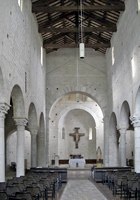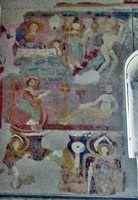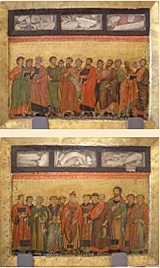


This is probably the site of the church of St Paul in Spoleto that is mentioned in the Dialogues of Pope Gregory I. Boniface, a monk in Sant’ Andrea, who had “until these four years last past remained amongst the Lombards” (i.e. until 589), told Gregory I about an Arian bishop who had arrived in Spoleto and “not having any place where to exercise his religion” had demanded that the Bishop of Spoleto should give him a church. When this was denied, the Arian threatened to “forcefully take possession of St. Paul's church, which was hard by his lodging”. The keeper of the church bolted the doors and hid inside until the next morning, when the Arian bishop and is men arrived to break down the door. Suddenly, the doors flew open, the lamps were lit by fire from Heaven and the Arian was blinded. After that, the “Lombards” were too afraid to “presume to violate Catholic places”.
The earliest reference to the present church, which was known as San Paolo inter Vineas (in the vineyard), dates to 1007, when Bishop Lupo gave it to the Abbess Berta so that she could establish a nunnery. The Bishop of Spoleto claimed jurisdiction over San Paolo during the reign of Pope Innocent III (1198-1216), but the papal legate ruled in the nuns' favour and the community was placed under papal protection.
In 1219, Cardinal Ugolino, the papal legate in Lombardy, Tuscany and Umbria and future Pope Gregory IX, imposed a new form of life upon the nuns of San Paolo and other "poor cloistered communities" of women who had hitherto followed no particular rule. The most prominent of these communities was that of the future St Clare and her sisters at San Damiano, Assisi, and the new order became known as the Poor Ladies of San Damiano (later the Poor Clares or second Order of St Francis).
This marked the start of an important era in the history of the complex:
-
✴Abbess Ugolina rebuilt the convent and restored the church some time before 1226.
-
✴In 1228, a few months after his elevation, Gregory IX appointed Cardinal Rinaldo dei Conti Segni (his nephew and the future Pope Alexander IV) as Cardinal Protector of the Poor Ladies: San Paolo was among the twenty nunneries to which the Cardinal addressed his letter of introduction.
-
✴In 1234, Pope Gregory IX re-consecrated the church and gave the nuns a number of precious relics and other gifts (see below).
There were close links between the Poor Ladies of San Paolo and the Franciscan friars at Sant' Elia, who officiated at their services and provided financial assistance. The friars generally were absolved of their responsibility for the Franciscan nuns from 1245 but this did not affect the situation in Spoleto. Indeed, in 1254, Pope Alexander IV gave the nuns a derogation from clausura so that the friars could help them in relation to the fabric of the church and convent.
In 1395 the nuns left for Sant’ Agata within the city walls, and the convent remained empty until a community of Observant Franciscans acquired it in 1461.
Later History of the Nuns
The nuns moved again from Sant’ Agata to Sant' Ansano in 1855. The community was was suppressed in 1868 but the nuns were able to regroup at St Alò in 1885. The community merged with that of Santa Lucia, Trevi in 1965. The remaining nuns at Sant' Alò moved there in 1974 when the complex was sold for residential use.
Observant Franciscans at San Paolo inter Vineas
Pope Pius II authorised Bishop Cardinal Berardo Eroli to cede San Paolo to the Observant Franciscans in 1461. He also founded an Observant Franciscan convent at San Girolamo, Narni in 1465, and decided that a group of friars should move there from San Paolo. The friars were reluctant because the opulence of San Girolamo was inconsistent with their vocation, but Cardinal Eroli was insistent. A group from San Paolo duly moved there in ca. 1471.
The friars of San Paolo were subsequently charged with the spiritual care of:
-
✴a new community of poor Clares at San Ponziano, at the behest of Pope Leo X in 1521; and
-
✴the female Franciscan tertiaries of Santa Caterina, at the behest of Pope Paul III in 1539.
When the Franciscan congregation that was known as the Clarini was suppressed in 1568, their Convento di Sant’ Antonio Abate on Monteluco passed to San Paolo inter Vineas.

The ex-convent now houses the Alberghiero di Giancarlo de Carolis, a catering college (further along Via San Paolo, on the right).
Exterior
The facade is in a single order with pilasters that articulate the nave and two aisles within.


The campanile was demolished in 1717, rebuilt in 1825 and demolished again in 1880.
Cloister - columns (10th century)?
Interior

The interior was completely re-modeled in 1771 and The interior was restored to something like its original appearance in 1953-65.
Colonnades of six Corinthian columns separate the nave from the two aisles. These terminate in triumphal arches that open onto a wide crossing that is punctuated by the shallow, semi-circular apse, which seems to be older than the rest of the church.
Frescoes (early 13th century)


These frescoes high up in the presbytery, which are related to those in the Abbazia di San Pietro in Valle, are thought to be among the oldest in the region. They were discovered during the recent restoration, detached for restoration and subsequently hung in their original locations.
The frescoes on the right wall depict:
-
✴to the left of the window:

-
•the creation of the world and the creation of Adam;
-
•God admonishes Adam; and
-
•God the Father enthroned between two Cherubs.
-
✴to the right of the window:

-
•Adam names the animals; and
-
•the creation of Eve.

SS Lucy and Paul (14th century)
These frescoes are on the right wall of the presbytery.
Annunciation (13th century)

Art from the Church

This display of works of art from San Paolo is in Room 11 of the Museo del Ducato di Spoleto.
-
✦The icon (ca. 1200) of Christ, which is now mounted below the Crucifix, seems to have been a gift to the nuns from Pope Gregory IX in 1234. It was probably painted in Venice and was subsequently enclosed in the present gilded silver reliquary (18th century).
-
✦Two double-sided reliquaries (late 13th or early 14th century) contain relics that Gregory IX also gave to the nuns in 1234:
-
✴The double-sided Crucifix depicts Christus Patiens with the Virgin and St John the Evangelist at the extremes of the cross. A number of relics are housed at the top of the cross: the inscription on the reverse records that they include a relic of the True Cross as well as relics of all the saints illustrated on the Crucifix.

-
✴The two reliquaries with pictures of saints originally formed a single, two-sided reliquary. The long inscriptions under the visible relics identify them as belonging to the saints depicted below.

The reliquaries were first documented in Sant’ Alò, and the painted images on them are the autograph works of the Maestro di Sant’ Alò. The nuns took these precious objects to Trevi when they moved there in 1965, but the Commune managed to acquire them in 1982.

